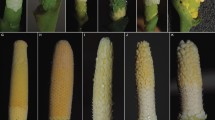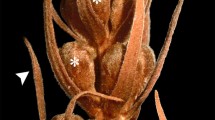Abstract
Androecial development of 13 species belonging to six tribes ofFlacourtiaceae has been investigated. While inScolopieae andFlacourtieae the stamens develop centrifugally, inErythrospermeae, Oncobeae andPangieae they are initiated in a centripetal sequence or a sequence that is neither distinctly centripetal nor centrifugal. The distribution of these developmental patterns coincides with the distribution of other characters (e.g. cyanogenic compounds, salicoid leaf teeth) and therefore supports a split of the family intoFlacourtiaceae s. str. (containing theScolopieae, Homalieae, Prockieae, Flacourtieae, Casearieae andBembicieae) andKiggelariaceae (withErythrospermeae, Oncobeae andPangieae) and is in accordance with results of recentrbcL studies.
Similar content being viewed by others
References
Chase, M. W., Lledo, M. D., Crespo, M. B., Swensen, S. M., 1996: When in doubt, put it in theFlacourtiaceae: molecular systematics ofFlacourtiaceae. — Amer. J. Bot.83 (6, Suppl.): 146.
,Learn, G. H. Jr.,Barrett, S. C. H., Graham, S., Dayanandan, S., Albert, V. A., 1993: Phylogenetics of seed plants: An analysis of nucleotide sequences from the plastid generbcL. — Ann. Missouri Bot. Gard.80: 528–580.
Conti, E., Litt, A., Sytsma, K., 1996: Circumscription ofMyrtales and their relationships to other rosids: Evidence fromrbcL sequence data. — Amer. J. Bot.83: 221–233.
Corner, E. J. H., 1946: Centrifugal stamens. — J. Arnold Arbor.27: 423–437.
, 1976: The seeds of dicotyledons. — Cambridge: Cambridge University Press.
Cronquist, A., 1957: Outline of a new system of families and orders of dicotyledons. — Bull. Jard. Bot. Natl. Belg.27: 13–40.
, 1981: An integrated system of classification of flowering plants. — New York: Columbia University Press.
, 1988: The evolution and classification of flowering plants. 2nd edn. — Bronx: New York Botanical Garden.
De Wilde, W. J. J. O., 1974: The genera of tribePassifloreae (Passifloraceae), with special reference to flower morphology. — Blumea22: 37–50.
Endress, P. K., 1976: Die Androeciumanlage bei polyandrischen Hamamelidaceen und ihre systematische Bedeutung. — Bot. Jahrb. Syst.97: 436–457.
, 1996: Diversity and evolutionary biology of tropical flowers. 2nd edn. — Cambridge: Cambridge University Press.
, 1975: Zur Androeciumanlage und Antherenentwicklung beiCaloncoba echinata (Flacourtiaceae). — Pl. Syst. Evol.123: 241–253.
Erdtman, G., 1952: Pollen morphology and plant taxonomy. — Stockholm: Almqvist & Wiksell.
Gilg, E., 1925:Flacourtiaceae. — InEngler, A., Prantl, K., (Eds): Die natürlichen Pflanzenfamilien, 2nd edn,21, pp. 377–457. — Leipzig: Engelmann.
Golysheva, M. D., 1975: Leaf anatomy ofIdesia polycarpa Maxim. and otherFlacourtiaceae in connection with the problem of affinitive interrelations between the familiesSalicaceae andFlacourtiaceae. — Bot. Zhurn. (Moscow & Leningrad)60: 787–799.
Hallier, H., 1908: ÜberJuliania, eine Terebinthaceen-Gattung mit Cupula, und die wahren Stammeltern der Kätzchenblütler. — Beih. Bot. Centralbl., Abt. II,23: 81–265.
Hickey, L. J., Wolfe, J. A., 1975: The bases of angiosperm phylogeny: Vegetative morphology. — Ann. Missouri Bot. Gard.62: 538–589.
Huber, H., 1991: Angiospermen. — Stuttgart: G. Fischer.
Hufford, L., 1990: Androecial development and the problem of monophyly ofLoasaceae. — Canad. J. Bot.68: 402–419.
Hul, S., Breteler, F. J., 1997: Réductions génériques dans lesOncobeae (Flacourtiaceae). — Adansonia19: 253–262.
Hutchinson, J., 1967: The genera of flowering plants. — Oxford: Clarendon Press.
Kaul, R. B., 1995: Reproductive structure and organogenesis in a cottonwood,Populus deltoides (Salicaceae). — Int. J. Pl. Sci.156: 172–180.
Keating, R. C., 1973: Pollen morphology of theFlacourtiaceae. — Ann. Missouri Bot. Gard.60: 273–305.
Leins, P., 1988: Das zentripetale Androeceum vonPunica. — Bot. Jahrb. Syst.109: 555–561.
, 1973: Entwicklungsgeschichtliche Studien an Loasaceen-Blüten. — Oesterr. Bot. Z.122: 145–165.
Lemke, D. E., 1988: A synopsis ofFlacourtiaceae. — Aliso12: 29–43.
Mayr, B., 1969: Ontogenetische Studien anMyrtales-Blüten. — Bot. Jahrb. Syst.89: 210–271.
Meeuse, A. D. J., 1975: Taxonomic relationships ofSalicaceae andFlacourtiaceae: their bearing on interpretative floral morphology and dilleniid phylogeny. — Acta. Bot. Neerl.24: 437–457.
Melchior, H., 1964:Violales. — InEngler, A., (Ed.): Syllabus der Pflanzenfamilien. 12th edn, pp. 322–340. — Berlin: Borntraeger.
Metcalfe, R. D., Chalk, L., 1950: Anatomy of the dicotyledons. — Oxford: Clarendon Press.
Miller, R. B., 1975: Systematic anatomy of the xylem and comments on the relationship ofFlacourtiaceae. — J. Arnold Arbor.56: 20–102.
Nandi, O., Chase, M. W., Endress, P. K., 1998: A combined cladistic analysis of angiosperms usingrbcL and non-molecular data sets. — Ann. Missouri Bot. Gard.85: 137–212.
Ronse Decraene, L. P., Smets, E. F., 1992: Complex polyandry in theMagnoliatae: definition, distribution and systematic value. — Nordic J. Bot.12: 621–649.
Spencer, K. C., Seigler, D. S., 1985: Cyanogenic glycosides and the systematics of theFlacourtiaceae. — Biochem. Syst. Ecol.13: 421–431.
Takhtajan, A., 1980: Outline of the classification of flowering plants. — Bot. Rev.46: 225–359.
, 1997: Diversity and classification of flowering plants. — New York: Columbia University Press.
Thorne, R. F., 1992: An updated phylogenetic classification of the flowering plants. — Aliso13: 365–389.
Van Heel, W. A., 1977: Flowers and fruits inFlacourtiaceae III. SomeOncobeae. — Blumea23: 349–369.
, 1979: Flowers and fruits inFlacourtiaceae IV.Hydnocarpus spp., Kiggelaria africana L.,Casearia spp., Berberidopsis corallina Hook. f. — Blumea25: 513–529.
Warburg, O., 1894:Flacourtiaceae. — InEngler, A., Prantl, K., (Eds): Die natürlichen Pflanzenfamilien,3/6a: 1–56. — Leipzig: Engelmann.
Author information
Authors and Affiliations
Rights and permissions
About this article
Cite this article
Bernhard, A., Endress, P.K. Androecial development and systematics inFlacourtiaceae s. l.. Pl Syst Evol 215, 141–155 (1999). https://doi.org/10.1007/BF00984652
Received:
Accepted:
Issue Date:
DOI: https://doi.org/10.1007/BF00984652




